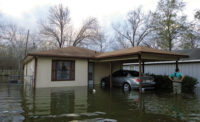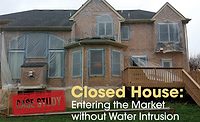Don't Damage Your Reputation: Spread Love, Not Mold or Debris



Be sure you are checking for other debris - like old dirt and dust - before kicking on air movers, especially in an already cluttered space.

Placing a lot of air movers in one place is not necessarily the answer. Be sure you are effectively balancing evaporation and dehumidification in a space you're remediating.






At the beginning of any restoration job, there is generally a feeling of hope, trust and good will that the job will be done correctly and the disaster will be erased. However, all that can change with the flick of a switch if an over-aggressive drying approach is applied at the wrong time.
It’s a basic principle of drying: air movement evaporates moisture and dehumidifiers extract the moisture from the air. So it seems logical when wet materials are encountered to begin the dry-out process as soon as any needed extraction is done. However, applying air movers in the wrong situation can not only make a job quickly go south, it can also land you in court.
Merely teaching a technician how to install drying equipment is not enough. They need to be taught to always analyze their surroundings and assess the potential side effects of turning on the air movers. It will save potential property damage issues, health issues, and customer confidence issues.
Here are some instances where technicians need to take a step back and assess the environment before installing the air movers.
1. Sewage Contaminations
Sewage contamination can contain bacteria, viruses and micro-organisms and requires careful treatment when first tackling the job. The use of air movers while any of these threats are present can spread these contaminants that are not normally aerosolized. Unlike mold spores, bacteria and micro-organisms are heavy and don’t normally become airborne, unless aggressively disturbed during the remediation process.
A sure way to spread this stuff around is to throw an air mover in to dry before the area is completely sanitized. During the sanitizing process, the use of negative air or dehumidification is acceptable.
2. Mold Situations
Dealing with mold is a sensitive issue of which most people are aware. However, what many fail to realize is most mold isn’t even visible to the naked eye. Those beautiful colors you see when mold is growing on the walls are either the mold’s flowers or excrement (yes, something ranks lower than mold – save that for your next insult). So, unlike when you punch a couch cushion and see a cloud of dust rise up in a sun beam, mold can’t be seen like that. If you get into mold and don’t have proper containment, then throw in an air mover, you can’t even see how far you have spread the spores.
When mitigating mold, cross contamination can be prevented by using 6-mil poly containment and negative air pressure. Air movers must not be used for drying until the remediation is complete, because they would pressurize and cross-contaminate mold.
Again, be aware of your surroundings and check to be sure the HVAC system is shut down during the remediation. Both the supply and return registers should be covered as well. Leave no opening unaddressed, because you might just fill a wall cavity with mold spores just waiting for the right conditions to grow and prosper.
3. Dry Debris Present
It cannot be stressed enough to be very aware of your surroundings when turning on air movers. If years of dry dust or dirt are present, it MUST be cleaned up first, or you will blow the debris around and where it settles can cause significant secondary damage.
A favorite case of mine involved a rather dirty basement with accumulation of dirt in several areas. The property owner repaired computers and had many stored in an unaffected portion of the basement. On went the fans without cleaning up the dirt and stirred up a dustbowl settling nicely into each computer. Whoops… there was some explaining to do on that one.
4. Cluttered Areas
It may be a clean water source and you have extracted the water from the floor, however, the area to be dried may be cluttered in more ways than you think. Before you turn on the powerful air movers, do a quick “walk of safety” to check the walls, and surfaces for loose materials or projectiles. Often, pictures or artwork on walls are not firmly secured and shake, rattle and even fly off. This can cause damage to the artwork, the walls and any furniture/fixture it may hit on the way down and the contractor will have to pay for all of it.
Even in the absence of resulting damage, when you cause the property owners belongings to fly around, your trust with them flies out the window.
5. Too Many Air Movers
A lot of air movers might look cool on the job, however, proper drying is a delicate balance between evaporation and dehumidification.
The case of the Mickey Mantle jersey illustrates this. Half of a home was damaged by water, leaving the other half untouched. In the unaffected area there was an autographed Mickey Mantle jersey hanging on display. The restoration technicians put in too many air movers and the dehumidifiers couldn’t keep up with the moisture. The result was secondary humidity damage in the unaffected side of the house and the autograph on the jersey became wet and ran, smearing the name.
Remember, restoration companies are cleaning companies, so be aware of your surroundings, keep things clean and orderly every step of the process and this will keep you out of trouble and keep the referrals coming.
Looking for a reprint of this article?
From high-res PDFs to custom plaques, order your copy today!










